
How to Write a DBQ Essay for APUSH

The Document Based Question (DBQ) essay is a key feature of the APUSH exam. And at 25% of your total score, it’s an important feature! Keep reading and you will get some great tips on how to write a DBQ for the APUSH exam.
What is a DBQ essay?
As I stated in a previous post on what the APUSH exam is all about , the goal of the exam is to test your historical thinking skills. Historians write arguments based on documents, and for this exam, you will, too.
For a DBQ essay, you will receive several documents of varying length. You will be asked to respond to some historical prompt that will require you to use the documents as evidence in your response. The great thing about a DBQ is that a lot of information you need to answer the question is in the documents themselves – score! However, you do need to have some background knowledge to make sense of the documents (we will practice this later in the post). The documents could be tables, charts, personal letters, or any other source that the exam creators believe would help you answer the question. Generally speaking, the documents will represent multiple perspectives on one topic.
It will be your job to synthesize those various perspectives into a coherent response.
Let’s walk through a sample DBQ topic for the APUSH exam.
Before we get too far into this, it’s important that you note that College Board, the organization that writes the APUSH exam, has made some major changes starting in 2015. I will be taking you through the 2015 sample the College Board provided for students to practice, but, as you will see in a second, it’s important that you practice as much as possible in order to read the documents quickly. Just make a note that the format may be slightly different if you review an exam prior to 2015.
Let’s say that you come across this prompt for a DBQ question:
Compare and contrast views of United States overseas expansion in the late nineteenth and early twentieth centuries. Evaluate how understandings of national identity, at the time, shaped these views.
Before you Read
You have 7 documents to read in the suggested time of 15 minutes. How is that even possible?!
Well, no one ever said it was going to be easy. But it is possible. When you get that prompt, or any other DBQ prompt like it, what you do before you read the documents will be just as important as what you end up writing. Before you even read the content of the documents, you should:
- Recall what you know about the time period.
- Read the source information for each document.
- Recognize the possible opinions that could be compared and contrasted.
Let’s dig into each of those steps.
1. Recall what you know
This DBQ is interested in U.S. overseas expansion in the late 19th and early 20th century. What do you know about U.S. overseas expansion during that time period? Perhaps you remember something about the Spanish-American War of 1898, which falls into our time period. Perhaps you remember that the U.S. got some territory as a result of that war. Even if you can’t remember exactly what territory, this puts you in a much better position to get started.
2. Read the source information
Take these two documents below as an example.
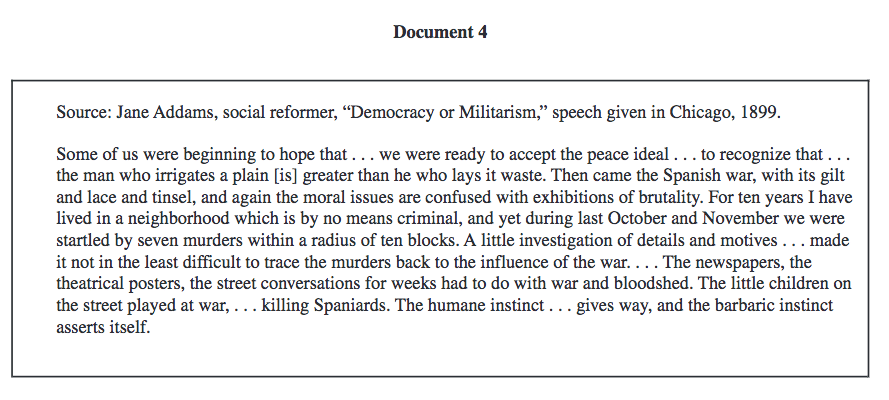
Before I read the document, I see that Jane Addams titled her speech “Democracy or Militarism.” Based on the title alone, I can begin to make some inferences that this document is not likely to be positive about any overseas expansion that would most certainly require military force.
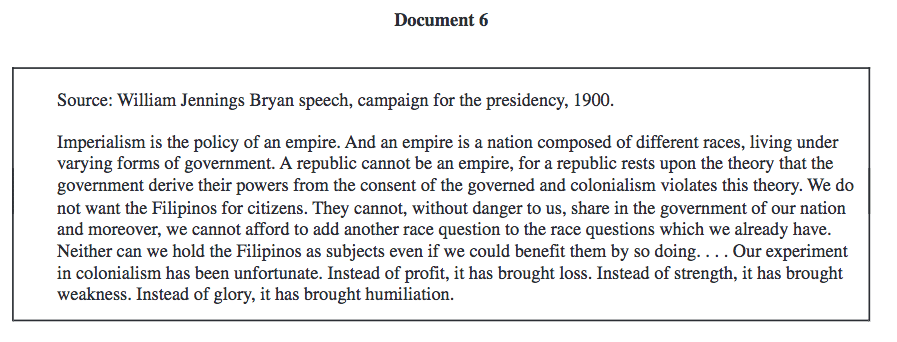
Before I even read this document, I can see that William Jennings Bryan is campaigning for the presidency. However, I cannot recall there ever being a President Bryan, meaning that he was unsuccessful in his campaign. Perhaps what he was saying was not popular enough to get enough votes.
These inferences help me make sense of the document later on.
3. Recognize possible opinions
Again, before I read the documents closely, I recognize that this is a compare/contrast question. Before I even read this document, I’m going to make the following table so that I can group documents later on.
This table will help me more easily write my essay.
I know that your instinct will be to see the clock and think, OH MY GOSH, I DON’T HAVE ENOUGH TIME TO BE DOING ALL THIS PREP WORK, MS. BERRY!!!!
Fight that instinct, because these steps will help you write a more coherent essay.
While you read
This part is tough. You have quite a few documents to make sense of in a short amount of time. But, as you are reading as fast as you can, you should be actively annotating the document for the following:
- Words, phrases, and/or visual cues that help you place the document into a group that helps you answer the question .
- Words, phrases, and/or visual cues that help you activate background knowledge .
- Words, phrases, and/or visual cues that help you understand the document’s bias .
You will have to practice this multiple times to get good at it; there’s really no way around that. But you have a plan of attack. So work your plan to make your plan work!
As you write
When you are writing your DBQ, use the five paragraph essay to your advantage. I am sure you know lots of other things that could turn this answer into a novel, but the most important thing for this task is to make sure that you get enough of your ideas on the page so that your APUSH exam scorer knows that you know.
- First paragraph: introduction with a thesis statement
- Second paragraph: documents FOR expansion (As you write, make sure to mention who is for expansion and compare/contrast that with who is against it.)
- Third paragraph: documents AGAINST expansion (As you write, make sure to mention who is against expansion and compare/contrast that with who is for it.)
- Fourth paragraph: documents with ambiguity or complicated arguments (You should compare these documents to BOTH groups.)
- Fifth paragraph: Conclusion that reiterates your argument
You may be thinking, why do I need that fourth paragraph? That seems needlessly complicated, to look for documents that are complicated.
Well, you are trying to score well on this DBQ, right? (Remember: it’s 25% of your overall score!)
You get a point for being able to do the following:
“Develop and support a cohesive argument that recognizes and accounts for historical complexity by explicitly illustrating relationships among historical evidence such as contradiction, corroboration, and/or qualification.” AP Scoring Guide
You will want that point!
I’ve given you a lot of information; but this information will become more like second nature the more you practice! For a summary, look at the table below.
And happy studying!
In summary: Strategies for writing the DBQ Essay

Allena Berry loves history; that should be known upfront. She loves it so much that she not only taught high school history and psychology after receiving her Master’s degree at Stanford University, she is now studying how students learn history at Northwestern. That being said, she does not have a favorite historical time period (so don’t bother asking). In addition to history, she enjoys writing, practicing yoga, and scouring Craigslist for her next DIY project or midcentury modern piece of furniture.
View all posts
More from Magoosh

Leave a Reply Cancel reply
Your email address will not be published. Required fields are marked *

Choose Your Test
Sat / act prep online guides and tips, how to write a dbq essay: key strategies and tips.
Advanced Placement (AP)

The DBQ, or document-based-question, is a somewhat unusually-formatted timed essay on the AP History Exams: AP US History, AP European History, and AP World History. Because of its unfamiliarity, many students are at a loss as to how to even prepare, let alone how to write a successful DBQ essay on test day.
Never fear! I, the DBQ wizard and master, have a wealth of preparation strategies for you, as well as advice on how to cram everything you need to cover into your limited DBQ writing time on exam day. When you're done reading this guide, you'll know exactly how to write a DBQ.
For a general overview of the DBQ—what it is, its purpose, its format, etc.—see my article "What is a DBQ?"
Table of Contents
What Should My Study Timeline Be?
Preparing for the DBQ
Establish a Baseline
Foundational Skills
Rubric Breakdown
Take Another Practice DBQ
How Can I Succeed on Test Day?
Reading the Question and Documents
Planning Your Essay
Writing Your Essay
Key Takeaways
What Should My DBQ Study Timeline Be?
Your AP exam study timeline depends on a few things. First, how much time you have to study per week, and how many hours you want to study in total? If you don't have much time per week, start a little earlier; if you will be able to devote a substantial amount of time per week (10-15 hours) to prep, you can wait until later in the year.
One thing to keep in mind, though, is that the earlier you start studying for your AP test, the less material you will have covered in class. Make sure you continually review older material as the school year goes on to keep things fresh in your mind, but in terms of DBQ prep it probably doesn't make sense to start before February or January at the absolute earliest.
Another factor is how much you need to work on. I recommend you complete a baseline DBQ around early February to see where you need to focus your efforts.
If, for example, you got a six out of seven and missed one point for doing further document analysis, you won't need to spend too much time studying how to write a DBQ. Maybe just do a document analysis exercise every few weeks and check in a couple months later with another timed practice DBQ to make sure you've got it.
However, if you got a two or three out of seven, you'll know you have more work to do, and you'll probably want to devote at least an hour or two every week to honing your skills.
The general flow of your preparation should be: take a practice DBQ, do focused skills practice, take another practice DBQ, do focused skills practice, take another practice DBQ, and so on. How often you take the practice DBQs and how many times you repeat the cycle really depends on how much preparation you need, and how often you want to check your progress. Take practice DBQs often enough that the format stays familiar, but not so much that you've done barely any skills practice in between.

He's ready to start studying!
The general preparation process is to diagnose, practice, test, and repeat. First, you'll figure out what you need to work on by establishing a baseline level for your DBQ skills. Then, you'll practice building skills. Finally, you'll take another DBQ to see how you've improved and what you still need to work on.
In this next section, I'll go over the whole process. First, I'll give guidance on how to establish a baseline. Then I'll go over some basic, foundational essay-writing skills and how to build them. After that I'll break down the DBQ rubric. You'll be acing practice DBQs before you know it!
#1: Establish a Baseline
The first thing you need to do is to establish a baseline— figure out where you are at with respect to your DBQ skills. This will let you know where you need to focus your preparation efforts.
To do this, you will take a timed, practice DBQ and have a trusted teacher or advisor grade it according to the appropriate rubric.
AP US History
For the AP US History DBQ, you'll be given a 15-minute reading period and 45 minutes of writing time.
A selection of practice questions from the exam can be found online at the College Board, including a DBQ. (Go to page 136 in the linked document for the practice prompt.)
If you've already seen this practice question, perhaps in class, you might use the 2015 DBQ question .
Other available College Board DBQs are going to be in the old format (find them in the "Free-Response Questions" documents). This is fine if you need to use them, but be sure to use the new rubric (which is out of seven points, rather than nine) to grade.
I advise you to save all these links , or even download all the Free Response Questions and the Scoring Guides, for reference because you will be using them again and again for practice.
AP European History
The College Board has provided practice questions for the exam , including a DBQ (see page 200 in the linked document).
If you've already seen this question, the only other questions available through the College Board are in the old format, because the 2016 DBQ is in a new, seven-point format identical to the AP US History exam. Just be sure to use the new DBQ rubric if you want to use any of the old prompts provided by the College Board . (DBQs are in the documents titled "Free-Response Questions.")
I advise you to save all these links (or even download all the Free Response Questions and the Scoring Guides) for reference, because you will be using them again and again for practice.

Who knows—maybe this will be one of your documents!
AP World History
For this exam, you'll be given a 15-minute reading period and 45 minutes of writing time . As for the other two history exams, the College Board has provided practice questions . See page 166 for the DBQ.
If you've already seen this question, the only other questions available through the College Board are in the old format, because the 2017 World History DBQ is in a new, seven-point format identical to the AP US History and AP European History exams. So be sure to use the new DBQ rubric if you want to use any of the old prompts provided by the College Board . (DBQs are in the documents titled "Free-Response Questions.")
Finding a Trusted Advisor to Look at Your Papers
A history teacher would be a great resource, but if they are not available to you in this capacity, here are some other ideas:
- An English teacher.
- Ask a librarian at your school or public library! If they can't help you, they may be able to direct you to resources who can.
- You could also ask a school guidance counselor to direct you to in-school resources you could use.
- A tutor. This is especially helpful if they are familiar with the test, although even if they aren't, they can still advise—the DBQ is mostly testing academic writing skills under pressure.
- Your parent(s)! Again, ideally your trusted advisor will be familiar with the AP, but if you have used your parents for writing help in the past they can also assist here.
- You might try an older friend who has already taken the exam and did well...although bear in mind that some people are better at doing than scoring and/or explaining!
Can I Prepare For My Baseline?
If you know nothing about the DBQ and you'd like to do a little basic familiarization before you establish your baseline, that's completely fine. There's no point in taking a practice exam if you are going to panic and muddle your way through it; it won't give a useful picture of your skills.
For a basic orientation, check out my article for a basic introduction to the DBQ including DBQ format.
If you want to look at one or two sample essays, see my article for a list of DBQ example essay resources . Keep in mind that you should use a fresh prompt you haven't seen to establish your baseline, though, so if you do look at samples don't use those prompts to set your baseline.
I would also check out this page about the various "task" words associated with AP essay questions . This page was created primarily for the AP European History Long Essay question, but the definitions are still useful for the DBQ on all the history exams, particularly since these are the definitions provided by the College Board.
Once you feel oriented, take your practice exam!
Don't worry if you don't do well on your first practice! That's what studying is for. The point of establishing a baseline is not to make you feel bad, but to empower you to focus your efforts on the areas you need to work on. Even if you need to work on all the areas, that is completely fine and doable! Every skill you need for the DBQ can be built .
In the following section, we'll go over these skills and how to build them for each exam.

You need a stronger foundation than this sand castle.
#2: Develop Foundational Skills
In this section, I'll discuss the foundational writing skills you need to write a DBQ.
I'll start with some general information on crafting an effective thesis , since this is a skill you will need for any DBQ exam (and for your entire academic life). Then, I'll go over outlining essays, with some sample outline ideas for the DBQ. After I'll touch on time management. Finally, I'll briefly discuss how to non-awkwardly integrate information from your documents into your writing.
It sounds like a lot, but not only are these skills vital to your academic career in general, you probably already have the basic building blocks to master them in your arsenal!
Writing An Effective Thesis
Writing a good thesis is a skill you will need to develop for all your DBQs, and for any essay you write, on the AP or otherwise.
Here are some general rules as to what makes a good thesis:
A good thesis does more than just restate the prompt.
Let's say our class prompt is: "Analyze the primary factors that led to the French Revolution."
Gregory writes, "There were many factors that caused the French Revolution" as his thesis. This is not an effective thesis. All it does is vaguely restate the prompt.
A good thesis makes a plausible claim that you can defend in an essay-length piece of writing.
Maybe Karen writes, "Marie Antoinette caused the French Revolution when she said ‘Let them eat cake' because it made people mad."
This is not an effective thesis, either. For one thing, Marie Antoinette never said that. More importantly, how are you going to write an entire essay on how one offhand comment by Marie Antoinette caused the entire Revolution? This is both implausible and overly simplistic.
A good thesis answers the question .
If LaToya writes, "The Reign of Terror led to the ultimate demise of the French Revolution and ultimately paved the way for Napoleon Bonaparte to seize control of France," she may be making a reasonable, defensible claim, but it doesn't answer the question, which is not about what happened after the Revolution, but what caused it!
A good thesis makes it clear where you are going in your essay.
Let's say Juan writes, "The French Revolution, while caused by a variety of political, social, and economic factors, was primarily incited by the emergence of the highly educated Bourgeois class." This thesis provides a mini-roadmap for the entire essay, laying out that Juan is going to discuss the political, social, and economic factors that led to the Revolution, in that order, and that he will argue that the members of the Bourgeois class were the ultimate inciters of the Revolution.
This is a great thesis! It answers the question, makes an overarching point, and provides a clear idea of what the writer is going to discuss in the essay.
To review: a good thesis makes a claim, responds to the prompt, and lays out what you will discuss in your essay.
If you feel like you have trouble telling the difference between a good thesis and a not-so-good one, here are a few resources you can consult:
This site from SUNY Empire has an exercise in choosing the best thesis from several options. It's meant for research papers, but the general rules as to what makes a good thesis apply.
About.com has another exercise in choosing thesis statements specifically for short essays. Note, however, that most of the correct answers here would be "good" thesis statements as opposed to "super" thesis statements.
- This guide from the University of Iowa provides some really helpful tips on writing a thesis for a history paper.
So how do you practice your thesis statement skills for the DBQ?
While you should definitely practice looking at DBQ questions and documents and writing a thesis in response to those, you may also find it useful to write some practice thesis statements in response to the Free-Response Questions. While you won't be taking any documents into account in your argument for the Free-Response Questions, it's good practice on how to construct an effective thesis in general.
You could even try writing multiple thesis statements in response to the same prompt! It is a great exercise to see how you could approach the prompt from different angles. Time yourself for 5-10 minutes to mimic the time pressure of the AP exam.
If possible, have a trusted advisor or friend look over your practice statements and give you feedback. Barring that, looking over the scoring guidelines for old prompts (accessible from the same page on the College Board where past free-response questions can be found) will provide you with useful tips on what might make a good thesis in response to a given prompt.
Once you can write a thesis, you need to be able to support it—that's where outlining comes in!
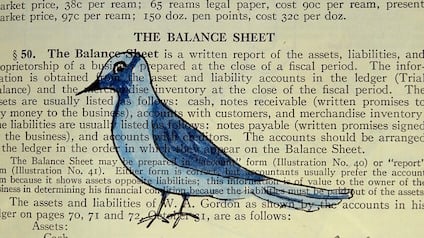
This is not a good outline.
Outlining and Formatting Your Essay
You may be the greatest document analyst and thesis-writer in the world, but if you don't know how to put it all together in a DBQ essay outline, you won't be able to write a cohesive, high-scoring essay on test day.
A good outline will clearly lay out your thesis and how you are going to support that thesis in your body paragraphs. It will keep your writing organized and prevent you from forgetting anything you want to mention!
For some general tips on writing outlines, this page from Roane State has some useful information. While the general principles of outlining an essay hold, the DBQ format is going to have its own unique outlining considerations.To that end, I've provided some brief sample outlines that will help you hit all the important points.
Sample DBQ Outline
- Introduction
- Thesis. The most important part of your intro!
- Body 1 - contextual information
- Any outside historical/contextual information
- Body 2 - First point
- Documents & analysis that support the first point
- If three body paragraphs: use about three documents, do deeper analysis on two
- Body 3 - Second point
- Documents & analysis that support the second point
- Use about three documents, do deeper analysis on two
- Be sure to mention your outside example if you have not done so yet!
- Body 4 (optional) - Third point
- Documents and analysis that support third point
- Re-state thesis
- Draw a comparison to another time period or situation (synthesis)
Depending on your number of body paragraphs and your main points, you may include different numbers of documents in each paragraph, or switch around where you place your contextual information, your outside example, or your synthesis.
There's no one right way to outline, just so long as each of your body paragraphs has a clear point that you support with documents, and you remember to do a deeper analysis on four documents, bring in outside historical information, and make a comparison to another historical situation or time (you will see these last points further explained in the rubric breakdown).
Of course, all the organizational skills in the world won't help you if you can't write your entire essay in the time allotted. The next section will cover time management skills.

You can be as organized as this library!
Time Management Skills for Essay Writing
Do you know all of your essay-writing skills, but just can't get a DBQ essay together in a 15-minute planning period and 40 minutes of writing?
There could be a few things at play here:
Do you find yourself spending a lot of time staring at a blank paper?
If you feel like you don't know where to start, spend one-two minutes brainstorming as soon as you read the question and the documents. Write anything here—don't censor yourself. No one will look at those notes but you!
After you've brainstormed for a bit, try to organize those thoughts into a thesis, and then into body paragraphs. It's better to start working and change things around than to waste time agonizing that you don't know the perfect thing to say.
Are you too anxious to start writing, or does anxiety distract you in the middle of your writing time? Do you just feel overwhelmed?
Sounds like test anxiety. Lots of people have this. (Including me! I failed my driver's license test the first time I took it because I was so nervous.)
You might talk to a guidance counselor about your anxiety. They will be able to provide advice and direct you to resources you can use.
There are also some valuable test anxiety resources online: try our guide to mindfulness (it's focused on the SAT, but the same concepts apply on any high-pressure test) and check out tips from Minnesota State University , these strategies from TeensHealth , or this plan for reducing anxiety from West Virginia University.
Are you only two thirds of the way through your essay when 40 minutes have passed?
You are probably spending too long on your outline, biting off more than you can chew, or both.
If you find yourself spending 20+ minutes outlining, you need to practice bringing down your outline time. Remember, an outline is just a guide for your essay—it is fine to switch things around as you are writing. It doesn't need to be perfect. To cut down on your outline time, practice just outlining for shorter and shorter time intervals. When you can write one in 20 minutes, bring it down to 18, then down to 16.
You may also be trying to cover too much in your paper. If you have five body paragraphs, you need to scale things back to three. If you are spending twenty minutes writing two paragraphs of contextual information, you need to trim it down to a few relevant sentences. Be mindful of where you are spending a lot of time, and target those areas.
You don't know the problem —you just can't get it done!
If you can't exactly pinpoint what's taking you so long, I advise you to simply practice writing DBQs in less and less time. Start with 20 minutes for your outline and 50 for your essay, (or longer, if you need). Then when you can do it in 20 and 50, move back to 18 minutes and 45 for writing, then to 15 and 40.
You absolutely can learn to manage your time effectively so that you can write a great DBQ in the time allotted. On to the next skill!
Integrating Citations
The final skill that isn't explicitly covered in the rubric, but will make a big difference in your essay quality, is integrating document citations into your essay. In other words, how do you reference the information in the documents in a clear, non-awkward way?
It is usually better to use the author or title of the document to identify a document instead of writing "Document A." So instead of writing "Document A describes the riot as...," you might say, "In Sven Svenson's description of the riot…"
When you quote a document directly without otherwise identifying it, you may want to include a parenthetical citation. For example, you might write, "The strikers were described as ‘valiant and true' by the working class citizens of the city (Document E)."

Now that we've reviewed the essential, foundational skills of the DBQ, I'll move into the rubric breakdowns. We'll discuss each skill the AP graders will be looking for when they score your exam. All of the history exams share a DBQ rubric, so the guidelines are identical.

Don't worry, you won't need a magnifying glass to examine the rubric.
#3: Learn the DBQ Rubric
The DBQ rubric has four sections for a total of seven points.
Part A: Thesis - 2 Points
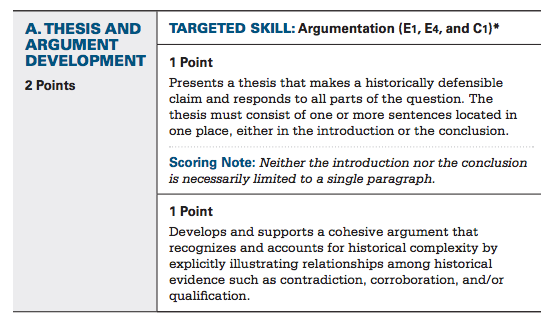
One point is for having a thesis that works and is historically defensible. This just means that your thesis can be reasonably supported by the documents and historical fact. So please don't make the main point of your essay that JFK was a member of the Illuminati or that Pope Urban II was an alien.
Per the College Board, your thesis needs to be located in your introduction or your conclusion. You've probably been taught to place your thesis in your intro, so stick with what you're used to. Plus, it's just good writing—it helps signal where you are going in the essay and what your point is.
You can receive another point for having a super thesis.
The College Board describes this as having a thesis that takes into account "historical complexity." Historical complexity is really just the idea that historical evidence does not always agree about everything, and that there are reasons for agreement, disagreement, etc.
How will you know whether the historical evidence agrees or disagrees? The documents! Suppose you are responding to a prompt about women's suffrage (suffrage is the right to vote, for those of you who haven't gotten to that unit in class yet):
"Analyze the responses to the women's suffrage movement in the United States."
Included among your documents, you have a letter from a suffragette passionately explaining why she feels women should have the vote, a copy of a suffragette's speech at a women's meeting, a letter from one congressman to another debating the pros and cons of suffrage, and a political cartoon displaying the death of society and the end of the ‘natural' order at the hands of female voters.
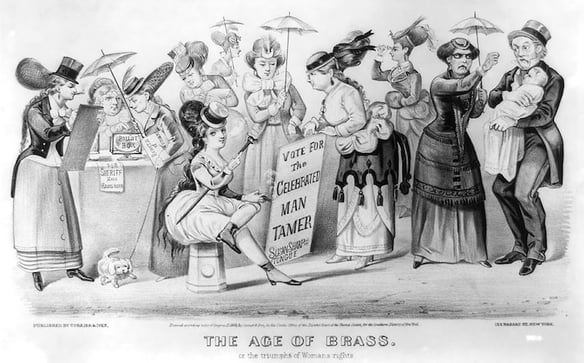
A simple but effective thesis might be something like,
"Though ultimately successful, the women's suffrage movement sharply divided the country between those who believed women's suffrage was unnatural and those who believed it was an inherent right of women."
This is good: it answers the question and clearly states the two responses to suffrage that are going to be analyzed in the essay.
A super thesis , however, would take the relationships between the documents (and the people behind the documents!) into account.
It might be something like,
"The dramatic contrast between those who responded in favor of women's suffrage and those who fought against it revealed a fundamental rift in American society centered on the role of women—whether women were ‘naturally' meant to be socially and civilly subordinate to men, or whether they were in fact equals."
This is a "super" thesis because it gets into the specifics of the relationship between historical factors and shows the broader picture —that is, what responses to women's suffrage revealed about the role of women in the United States overall.
It goes beyond just analyzing the specific issues to a "so what"? It doesn't just take a position about history, it tells the reader why they should care . In this case, our super thesis tells us that the reader should care about women's suffrage because the issue reveals a fundamental conflict in America over the position of women in society.
Part B: Document Analysis - 2 Points
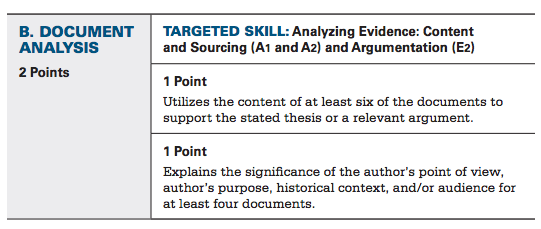
One point for using six or seven of the documents in your essay to support your argument. Easy-peasy! However, make sure you aren't just summarizing documents in a list, but are tying them back to the main points of your paragraphs.
It's best to avoid writing things like, "Document A says X, and Document B says Y, and Document C says Z." Instead, you might write something like, "The anonymous author of Document C expresses his support and admiration for the suffragettes but also expresses fear that giving women the right to vote will lead to conflict in the home, highlighting the common fear that women's suffrage would lead to upheaval in women's traditional role in society."
Any summarizing should be connected a point. Essentially, any explanation of what a document says needs to be tied to a "so what?" If it's not clear to you why what you are writing about a document is related to your main point, it's not going to be clear to the AP grader.
You can get an additional point here for doing further analysis on 4 of the documents. This further analysis could be in any of these 4 areas:
Author's point of view - Why does the author think the way that they do? What is their position in society and how does this influence what they are saying?
Author's purpose - Why is the author writing what they are writing? What are they trying to convince their audience of?
Historical context - What broader historical facts are relevant to this document?
Audience - Who is the intended audience for this document? Who is the author addressing or trying to convince?
Be sure to tie any further analysis back to your main argument! And remember, you only have to do this for four documents for full credit, but it's fine to do it for more if you can.
Practicing Document Analysis
So how do you practice document analysis? By analyzing documents!
Luckily for AP test takers everywhere, New York State has an exam called the Regents Exam that has its own DBQ section. Before they write the essay, however, New York students have to answer short answer questions about the documents.
Answering Regents exam DBQ short-answer questions is good practice for basic document analysis. While most of the questions are pretty basic, it's a good warm-up in terms of thinking more deeply about the documents and how to use them. This set of Regent-style DBQs from the Teacher's Project are mostly about US History, but the practice could be good for other tests too.
This prompt from the Morningside center also has some good document comprehensions questions about a US-History based prompt.
Note: While the document short-answer questions are useful for thinking about basic document analysis, I wouldn't advise completing entire Regents exam DBQ essay prompts for practice, because the format and rubric are both somewhat different from the AP.
Your AP history textbook may also have documents with questions that you can use to practice. Flip around in there!

This otter is ready to swim in the waters of the DBQ.
When you want to do a deeper dive on the documents, you can also pull out those old College Board DBQ prompts.
Read the documents carefully. Write down everything that comes to your attention. Do further analysis—author's point of view, purpose, audience, and historical context—on all the documents for practice, even though you will only need to do additional analysis on four on test day. Of course, you might not be able to do all kinds of further analysis on things like maps and graphs, which is fine.
You might also try thinking about how you would arrange those observations in an argument, or even try writing a practice outline! This exercise would combine your thesis and document-analysis skills practice.
When you've analyzed everything you can possibly think of for all the documents, pull up the Scoring Guide for that prompt. It helpfully has an entire list of analysis points for each document.
Consider what they identified that you missed.
Do you seem way off-base in your interpretation? If so, how did it happen?
Part C: Using Evidence Beyond the Documents - 2 Points
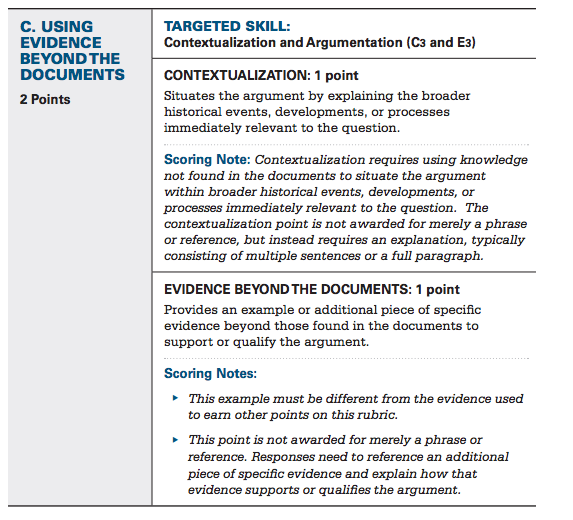
Don't be freaked out by the fact that this is two points!
One point is just for context—if you can locate the issue within its broader historical situation. You do need to write several sentences to a paragraph about it, but don't stress; all you really need to know to be able to get this point is information about major historical trends over time, and you will need to know this anyways for the multiple choice section. If the question is about the Dust Bowl during the Great Depression, for example, be sure to include some of the general information you know about the Great Depression! Boom. Contextualized.
The other point is for naming a specific, relevant example in your essay that does not appear in the documents.
To practice your outside information skills, pull up your College Board prompts!
Read through the prompt and documents and then write down all of the contextualizing facts and as many specific examples as you can think of.
I advise timing yourself—maybe 5-10 minutes to read the documents and prompt and list your outside knowledge—to imitate the time pressure of the DBQ.
When you've exhausted your knowledge, make sure to fact-check your examples and your contextual information! You don't want to use incorrect information on test day.
If you can't remember any examples or contextual information about that topic, look some up! This will help fill in holes in your knowledge.
Part D: Synthesis - 1 Point
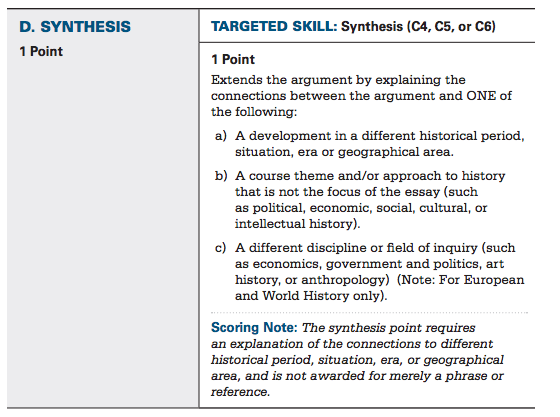
All you need to do for synthesis is relate your argument about this specific time period to a different time period, geographical area, historical movement, etc. It is probably easiest to do this in the conclusion of the essay. If your essay is about the Great Depression, you might relate it to the Great Recession of 2007-2009.
You do need to do more than just mention your synthesis connection. You need to make it meaningful. How are the two things you are comparing similar? What does one reveal about the other? Is there a key difference that highlights something important?
To practice your synthesis skills—you guessed it—pull up your College Board prompts!
- Read through the prompt and documents and then identify what historical connections you could make for your synthesis point. Be sure to write a few words on why the connection is significant!
- A great way to make sure that your synthesis connection makes sense is to explain it to someone else. If you explain what you think the connection is and they get it, you're probably on the right track.
- You can also look at sample responses and the scoring guide for the old prompts to see what other connections students and AP graders made.
That's a wrap on the rubric! Let's move on to skill-building strategy.

I know you're tired, but you can do it!
#5: Take Another Practice DBQ
So, you established a baseline, identified the skills you need to work on, and practiced writing a thesis statement and analyzing documents for hours. What now?
Take another timed, practice DBQ from a prompt you haven't seen before to check how you've improved. Recruit your same trusted advisor to grade your exam and give feedback. After, work on any skills that still need to be honed.
Repeat this process as necessary, until you are consistently scoring your goal score. Then you just need to make sure you maintain your skills until test day by doing an occasional practice DBQ.
Eventually, test day will come—read on for my DBQ-test-taking tips.
How Can I Succeed On DBQ Test Day?
Once you've prepped your brains out, you still have to take the test! I know, I know. But I've got some advice on how to make sure all of your hard work pays off on test day—both some general tips and some specific advice on how to write a DBQ.
#1: General Test-Taking Tips
Most of these are probably tips you've heard before, but they bear repeating:
Get a good night's sleep for the two nights preceding the exam. This will keep your memory sharp!
Eat a good breakfast (and lunch, if the exam is in the afternoon) before the exam with protein and whole grains. This will keep your blood sugar from crashing and making you tired during the exam.
Don't study the night before the exam if you can help it. Instead, do something relaxing. You've been preparing, and you will have an easier time on exam day if you aren't stressed from trying to cram the night before.

This dude knows he needs to get a good night's rest!
#2: DBQ Plan and Strategies
Below I've laid out how to use your time during the DBQ exam. I'll provide tips on reading the question and docs, planning your essay, and writing!
Be sure to keep an eye on the clock throughout so you can track your general progress.
Reading the Question and the Documents: 5-6 min
First thing's first: r ead the question carefully , two or even three times. You may want to circle the task words ("analyze," "describe," "evaluate," "compare") to make sure they stand out.
You could also quickly jot down some contextual information you already know before moving on to the documents, but if you can't remember any right then, move on to the docs and let them jog your memory.
It's fine to have a general idea of a thesis after you read the question, but if you don't, move on to the docs and let them guide you in the right direction.
Next, move on to the documents. Mark them as you read—circle things that seem important, jot thoughts and notes in the margins.
After you've passed over the documents once, you should choose the four documents you are going to analyze more deeply and read them again. You probably won't be analyzing the author's purpose for sources like maps and charts. Good choices are documents in which the author's social or political position and stake in the issue at hand are clear.

Get ready to go down the document rabbit hole.
Planning Your Essay: 9-11 min
Once you've read the question and you have preliminary notes on the documents, it's time to start working on a thesis. If you still aren't sure what to talk about, spend a minute or so brainstorming. Write down themes and concepts that seem important and create a thesis from those. Remember, your thesis needs to answer the question and make a claim!
When you've got a thesis, it's time to work on an outline . Once you've got some appropriate topics for your body paragraphs, use your notes on the documents to populate your outline. Which documents support which ideas? You don't need to use every little thought you had about the document when you read it, but you should be sure to use every document.
Here's three things to make sure of:
Make sure your outline notes where you are going to include your contextual information (often placed in the first body paragraph, but this is up to you), your specific example (likely in one of the body paragraphs), and your synthesis (the conclusion is a good place for this).
Make sure you've also integrated the four documents you are going to further analyze and how to analyze them.
Make sure you use all the documents! I can't stress this enough. Take a quick pass over your outline and the docs and make sure all of the docs appear in your outline.
If you go over the planning time a couple of minutes, it's not the end of the world. This probably just means you have a really thorough outline! But be ready to write pretty fast.
Writing the Essay - 45 min
If you have a good outline, the hard part is out of the way! You just need to make sure you get all of your great ideas down in the test booklet.
Don't get too bogged down in writing a super-exciting introduction. You won't get points for it, so trying to be fancy will just waste time. Spend maybe one or two sentences introducing the issue, then get right to your thesis.
For your body paragraphs, make sure your topic sentences clearly state the point of the paragraph . Then you can get right into your evidence and your document analysis.
As you write, make sure to keep an eye on the time. You want to be a little more than halfway through at the 20-minute mark of the writing period, so you have a couple minutes to go back and edit your essay at the end.
Keep in mind that it's more important to clearly lay out your argument than to use flowery language. Sentences that are shorter and to the point are completely fine.
If you are short on time, the conclusion is the least important part of your essay . Even just one sentence to wrap things up is fine just so long as you've hit all the points you need to (i.e. don't skip your conclusion if you still need to put in your synthesis example).
When you are done, make one last past through your essay. Make sure you included everything that was in your outline and hit all the rubric skills! Then take a deep breath and pat yourself on the back.

You did it!! Have a cupcake to celebrate.
Key Tips for How to Write a DBQ
I realize I've bombarded you with information, so here are the key points to take away:
Remember the drill for prep: establish a baseline, build skills, take another practice DBQ, repeat skill-building as necessary.
Make sure that you know the rubric inside and out so you will remember to hit all the necessary points on test day! It's easy to lose points just for forgetting something like your synthesis point.
On test day, keep yourself on track time-wise !
This may seem like a lot, but you can learn how to ace your DBQ! With a combination of preparation and good test-taking strategy, you will get the score you're aiming for. The more you practice, the more natural it will seem, until every DBQ is a breeze.
What's Next?
If you want more information about the DBQ, see my introductory guide to the DBQ .
Haven't registered for your AP test yet? See our article for help registering for AP exams .
For more on studying for the AP US History exam, check out the best AP US History notes to study with .
Studying for World History? See these AP World History study tips from one of our experts.

Ellen has extensive education mentorship experience and is deeply committed to helping students succeed in all areas of life. She received a BA from Harvard in Folklore and Mythology and is currently pursuing graduate studies at Columbia University.
Ask a Question Below
Have any questions about this article or other topics? Ask below and we'll reply!
Improve With Our Famous Guides
- For All Students
The 5 Strategies You Must Be Using to Improve 160+ SAT Points
How to Get a Perfect 1600, by a Perfect Scorer
Series: How to Get 800 on Each SAT Section:
Score 800 on SAT Math
Score 800 on SAT Reading
Score 800 on SAT Writing
Series: How to Get to 600 on Each SAT Section:
Score 600 on SAT Math
Score 600 on SAT Reading
Score 600 on SAT Writing
Free Complete Official SAT Practice Tests
What SAT Target Score Should You Be Aiming For?
15 Strategies to Improve Your SAT Essay
The 5 Strategies You Must Be Using to Improve 4+ ACT Points
How to Get a Perfect 36 ACT, by a Perfect Scorer
Series: How to Get 36 on Each ACT Section:
36 on ACT English
36 on ACT Math
36 on ACT Reading
36 on ACT Science
Series: How to Get to 24 on Each ACT Section:
24 on ACT English
24 on ACT Math
24 on ACT Reading
24 on ACT Science
What ACT target score should you be aiming for?
ACT Vocabulary You Must Know
ACT Writing: 15 Tips to Raise Your Essay Score
How to Get Into Harvard and the Ivy League
How to Get a Perfect 4.0 GPA
How to Write an Amazing College Essay
What Exactly Are Colleges Looking For?
Is the ACT easier than the SAT? A Comprehensive Guide
Should you retake your SAT or ACT?
When should you take the SAT or ACT?
Stay Informed
Get the latest articles and test prep tips!

Looking for Graduate School Test Prep?
Check out our top-rated graduate blogs here:
GRE Online Prep Blog
GMAT Online Prep Blog
TOEFL Online Prep Blog
Holly R. "I am absolutely overjoyed and cannot thank you enough for helping me!”
Find what you need to study
AP World Long Essay Question (LEQ) Overview
15 min read • may 10, 2022

Zaina Siddiqi
Exam simulation mode
Prep for the AP exam with questions that mimic the test!
Overview of the Long Essay Question (LEQ)
Section II of the AP Exam includes three Long Essay Question (LEQ) prompts. You will choose to write about just one of these.
The formatting of prompts varies somewhat between the AP Histories, though the rubric does not. In AP World History, the prompt includes a sentence that orients the writer to the time, place, and theme of the prompt topic, while prompts in AP US History and AP European History typically do not. However, the rubrics and scoring guidelines are the same for all Histories.
Your answer should include the following:
A valid thesis
A discussion of relevant historical context
Use of evidence supports your thesis
Use of a reasoning skill to organize and structure the argument
Complex understanding of the topic of the prompt
We will break down each of these aspects in the next section. For now, the gist is that you need to write an essay that answers the prompt, using evidence. You will need to structure and develop your essay using one of the course reasoning skills.
Many of the skills you need to write a successful LEQ essay are the same skills you will use on the DBQ. In fact, some of the rubric points are identical, so you can use a lot of the same strategies on both writing tasks!
You will have three choices of prompts for your LEQ. All three prompts will focus on the same reasoning skills, but the time periods will differ in each prompt. Prompt topics may span across time periods specified in the course outline, and the time period breakdowns for each prompt are as follows:
Writing time on the AP Exam includes both the Document Based Question (DBQ) and the (LEQ), but it is suggested that you spend 40 minutes completing the LEQ. You will need to plan and write your essay in that time.
A good breakdown would be 5 min. (planning) + 35 min. (writing) = 40 min.
The LEQ is scored on a rubric out of six points, and is weighted at 15% of your overall exam score. We’ll break down the rubric next.
How to Rock the LEQ: The Rubric
The LEQ is scored on a six point rubric, and each point can be earned independently. That means you can miss a point on something and still earn other points with the great parts of your essay.
Note: all of the examples in this section will be for this prompt from AP World History: Modern. You could use similar language, structure, or skills to write samples for prompts in AP US History or AP European History.
Let’s break down each rubric component...
What is it?
The thesis is a brief statement that introduces your argument or claim, and can be supported with evidence and analysis. This is where you answer the prompt.
Where do I write it?
This is the only element in the essay that has a required location. The thesis needs to be in your introduction or conclusion of your essay. It can be more than one sentence, but all of the sentences that make up your thesis must be consecutive in order to count.
How do I know if mine is good?
The most important part of your thesis is the claim , which is your answer to the prompt. The description the College-Board gives is that it should be “historically defensible,” which really means that your evidence must be plausible. On the LEQ, your thesis needs to be related topic of the prompt.
Your thesis should also establish your line of reasoning. Translation: address why or how something happened - think of this as the “because” to the implied “how/why” of the prompt. This sets up the framework for the body of your essay, since you can use the reasoning from your thesis to structure your body paragraph topics later.
The claim and reasoning are the required elements of the thesis. And if that’s all you can do, you’re in good shape to earn the point.
Going above-and-beyond to create a more complex thesis can help you in the long run, so it’s worth your time to try. One way to build in complexity to your thesis is to think about a counter-claim or alternate viewpoint that is relevant to your response. If you are using one of the course reasoning process to structure your essay (and you should!) think about using that framework for your thesis too.
In a causation essay, a complex argument addresses causes and effects.
In a comparison essay, a complex argument addresses similarities and differences.
In a continuity and change over time essay, a complex argument addresses change and continuity .
This counter-claim or alternate viewpoint can look like an “although” or “however” phrase in your thesis.
Powers in both land-based and maritime empires had to adapt their rule to accommodate diverse populations. However, in this era land-based empires were more focused on direct political control, while the maritime empires were more based on trade and economic development.
This thesis works because it clearly addresses the prompt (comparing land and maritime empires). It starts by addressing a similarity, and then specifies a clear difference with a line of reasoning to clarify the actions of the land vs. maritime empires.
Contextualization
Contextualization is a brief statement that lays out the broader historical background relevant to the prompt.
There are a lot of good metaphors out there for contextualization, including the “previously on…” at the beginning of some TV shows, or the famous text crawl at the beginning of the Star Wars movies.
Both of these examples serve the same function: they give important information about what has happened off-screen that the audience needs to know to understand what is about to happen on-screen.
In your essay, contextualization is the same. You give your reader information about what else has happened, or is happening, in history that will help them understand the specific topic and argument you are about to make.
There is no specific requirement for where contextualization must appear in your essay. The easiest place to include it, however, is in your introduction . Use context to get your reader acquainted with the time, place, and theme of your essay, then transition into your thesis.
Good contextualization doesn’t have to be long, and it doesn’t have to go into a ton of detail, but it does need to do a few very specific things.
Your contextualization needs to refer to events, developments and/or processes outside the time and place of the prompt. It could address something that occurred in an earlier era in the same region as the topic of the prompt, or it could address something happening at the same time as the prompt, but in a different place. Briefly describe this outside information.
Then, connect it to your thesis/argument. The language from the College Board is that contextualization must be “relevant to the prompt,” and in practical terms this means you have to show the connection. A transition sentence or phrase is useful here (plus, this is why contextualization makes the most sense in the introduction!)
Also, contextualization needs to be multiple consecutive sentences, so it’s all one argument (not sprinkled around in a paragraph). The introduction is the best place for contextualization, but not the only place.
Basically, choose a connected topic that “sets the stage” for your thesis, and briefly describe it in a couple sentences. Then, make a clear connection to the argument of your thesis from that outside information.
In the period 1450-1750, both European and Asian powers expanded their reach and created large empires across the world. In Asia, the trend was toward large, land-based empires which were controlled from a central capital city. Europeans built empires that stretched across oceans included territories in the Americas, Africa, and Asia.
This contextualization works by addressing the time period of the prompt and establishing basic definitions for empire-building and the types of empires (land and maritimes.) These definitions will be valuable context for seeing the comparisons developed in the thesis and body paragraphs of this essay.
Evidence: Provide Specific Examples
For this point, the focus is simply about having evidence. Evidence is the historical detail you include in your writing. The specific facts and examples that prove your argument. In the LEQ, your evidence comes your knowledge of history.
Evidence goes in your body paragraphs. In fact, the bulk of your body paragraphs will be made up of evidence and supporting analysis or commentary that connects that evidence to other evidence and/or to the argument you are making.
Good evidence is specific, accurate, and relevant to the prompt. For this point, simply including multiple pieces of quality evidence is enough. If you’re a numbers person, a good starting point is to aim for two pieces of quality evidence in each body paragraph and go up from there.
In order for your evidence to count for this point, it needs to be really specific. Using course-specific vocabulary is a great strategy here to know that you are writing specific evidence. If you can’t remember a specific vocabulary term, describe what you mean in plain language with as much detail as possible.
Though the Ottoman Sultans were Muslims, they ruled over a population that included fellow Muslims, Christians, and Jews.
This evidence works because it includes specific and relevant details, namely the religions of both the Ottoman rulers and the diverse population they ruled over.
Evidence: Supports an Argument with Evidence
In addition to having evidence, this point is about using that evidence to support an argument in response to the prompt. Basically, connect your evidence back to your topic sentence and/or thesis.
Supporting statements go with your evidence in your body paragraph. Ideally, a connecting statement comes right before or after a piece of evidence.
This point is harder to earn than the previous evidence point, because it’s a little more difficult to explain fully.
One way to know if you are doing this at all is to look at the topic sentences of your body paragraphs. First of all, do you have one? You should. The first sentence of your body paragraph should make it clear what you are talking about in that paragraph. It should relate to some aspect of your thesis, and it should be connected to the reasoning skill you have chosen to organize your argument.
One characteristic shared by both kinds of empires was the need to adapt to diverse populations. As the Ottoman empire expanded its influence, it took over territory previously controlled by the Byzantines. Though the Ottoman Sultans were Muslims, they now ruled over a population that included fellow Muslims, Christians, and Jews. In order to keep peace within their empire, the Ottomans allowed people to continue practicing their traditional faiths. Ottoman cities such as Istanbul had areas of the cities set aside where different groups could live and worship without interference from others .
This section works because it defines the adaptation made by Ottoman rulers to effectively rule a diverse population, and elaborates on both how and why that adaptation was made.
Following your topic sentence, your body paragraph should elaborate on the idea in that topic sentence, using the evidence to prove your point. At first, you may rely on phrases like “this shows…” or “this means…,” which can get repetitive, but may also help you know when you are making the connections between evidence and argument explicit.
Analysis and Reasoning: Historical Reasoning
A good argument needs structure, and yours needs to use one of the course reasoning skills to create that structure. You can choose whichever skill works best for a particular prompt: causation , comparison , or continuity and change over time .
Strong reasoning goes throughout an essay, so this will be the overarching structure of your writing from the thesis through your body paragraphs.
The reasoning doesn’t necessarily have to be completely balanced or even in order to count, which gives you room to write about what you know best. For example, in an essay structured around continuity and change, you might spend most of your time addressing changes and relatively little time addressing continuity. And that’s ok.
The best essays do address both “sides” of the historical reasoning, and yours should too. If you created a complex thesis in your introduction, you can extend those ideas into your body paragraphs. Even if you don’t have equal sentences or paragraphs for each topic, as long as you address the reasoning process in your essay, you’re on the right track.
Analysis and Reasoning: Complexity
The second part of the Analysis and Reasoning scoring category is complexity. This is by far the most challenging part of the LEQ, and the point earned by the fewest students. It isn’t impossible, just difficult. Part of the difficulty is that it is the least concrete skill to teach and practice.
If you’re already feeling overwhelmed by the time limits of the LEQ, don’t stress about complexity. Focus on writing the best essay you can that answers the prompt. Plenty of students earn 5’s without the complexity point.
If you are ready to tackle this challenge, keep reading!
The College Board awards this point for essays that “demonstrate a complex understanding” of the topic of the prompt.
Complexity cannot be earned with a single sentence or phrase. It must show up throughout the essay.
A complex argument starts with a complex thesis. A complex thesis must address the topic of the prompt in more than one way. Including a counter-claim or alternate viewpoint in the thesis is a good way to set up a complex argument, because it builds in room within the structure of your essay to address more than one idea (provided your body paragraphs follow the structure of your thesis!)
A complex argument may include corroboration - evidence that supports or confirms the premise of the argument. Clear explanation that connects each piece of evidence to the thesis will help do this. In the LEQ, your evidence is all from your knowledge of history, so it’s up to you to fully explain how that evidence backs up your thesis. Consistent, thoughtful explanation can go a long way toward the complexity point.
A complex argument may also include qualification - evidence that limits or counters an initial claim. This isn’t the same as undoing or undermining your claim. Qualifying a claim shows that it isn’t universal. An example of this might be including continuity in an essay that is primarily about change.
A final way to introduce complexity to your argument is through modification - using evidence to change your claim or argument as it develops. Modification isn’t quite as extreme as qualification, but it shows that the initial claim may be too simple to encompass the reality of history.
Since no single sentence can demonstrate complexity on its own, it’s difficult to show examples of complex arguments. Fully discussing your claim and its line of reasoning, and fairly addressing your counter-claim or alternate view is the strongest structure to aim for a complexity point. Explain everything as you go and aim for success!
How to Rock the LEQ: The Process
Before you start writing....
It is tempting to just start writing at the beginning of your LEQ time, especially if you took extra time to write your DBQ and you’re feeling some pressure. It’s actually better to take a few minutes to analyze the prompt and plan your essay before you start writing to give yourself the best shot at success. You might surprise yourself with how quickly an essay comes together after you create a solid plan.
The very first thing you should do with any prompt is to be sure you understand the question . Misunderstanding the time period, topic, or geographic region of a prompt can kill a thoughtful and well-argued essay. When you’re practicing early in the year, go ahead and re-write the prompt as a question. Later on you can re-phrase it mentally without all the work.
As you think about the question, start thinking about which reasoning skill might apply best for this prompt: causation, comparison, or continuity and change over time.
Original prompt - Develop an argument that compares the process of empire building in land-based and maritime empires in the period 1450-1750 CE.
Revised - What were the key similarities and differences in the ways that land-based (Asian) and maritime (European) empires built their governments and power between 1450-1750?
Now that you know what you’re writing about, take a few minutes to brainstorm what you know about that topic. You can make a simple graphic organizer to help you see relationships between information (i.e. a Venn diagram, T-chart, timeline, etc.), or just jot down ideas as they come to mind.
Go back over you list and mark which ideas work best as context (generally broader and less related to the prompt) and which ideas work best as evidence (more specific.)
If you have time, brainstorm a sample thesis and/or outline for how you want to structure your ideas. This may seem like an extravagance with limited time, but it can be a great cheat sheet for you if you lose your way in the middle of a body paragraph.
When you have a plan you like, start writing!
Writing the essay
Your introduction should include your contextualization and thesis. Start with a statement that establishes your time and place in history, and follow that with a brief description of the historical situation. Connect that broader context to the theme and topic of the prompt. Then, make a claim that answers the prompt, with an overview of your reasoning and any counter-claim you plan to address.
Body paragraphs will vary in length, depending on how many documents or other pieces of evidence you include, but should follow a consistent structure. Start with a topic sentence that introduces the specific aspect of the prompt that paragraph will address. There aren’t specific points for topic sentences, but they will help you stay focused.
Follow your topic sentence with a piece of evidence and connect it back to your topic sentence and/or thesis. Continue with 1-2 pieces of evidence and more explanation until you have completed the argument of your topic sentence. Then start a new paragraph with a new topic sentence.
Each body paragraph will follow this general format, and there is no set number of paragraphs for the LEQ (minimum or maximum.) Write as many paragraphs as you need to fully answer the prompt by developing the argument (and counter-argument if applicable) from your thesis.
If you have time, you may choose to write a conclusion . It isn’t necessary, so you can drop it if you’re rushed. BUT, the conclusion is the only place where you can earn the thesis point outside the introduction, so it’s not a bad idea. You could re-state your thesis in new wording, or give any final thoughts in terms of analysis about your topic. You might solidify your complexity point in the conclusion if written well.
Since most people write the DBQ first, when you finish the LEQ you’re done with your AP Exam. Congratulations!
Sample Prompts
AP World History: Modern
In the period 1450-1750 CE, empires achieved increased scope and influence around the world, shaping and being shaped by the diverse populations they incorporated.
Develop an argument that compares the process of empire building in land-based and maritime empires in the period 1450-1750 CE.
AP US History
Evaluate the extent to which Massachusetts and Virginia differed in the ways that economic development affected their politics between 1607 and 1750.
AP European History
Evaluate the effectiveness of challenges to royal authority in Eastern Europe in the seventeenth and eighteenth centuries.
The LEQ Rubric (Quick Reference)
Stay Connected
© 2024 Fiveable Inc. All rights reserved.
AP® and SAT® are trademarks registered by the College Board, which is not affiliated with, and does not endorse this website.
Recently viewed courses
Recently viewed.
Find Your Dream School
This site uses various technologies, as described in our Privacy Policy, for personalization, measuring website use/performance, and targeted advertising, which may include storing and sharing information about your site visit with third parties. By continuing to use this website you consent to our Privacy Policy and Terms of Use .
COVID-19 Update: To help students through this crisis, The Princeton Review will continue our "Enroll with Confidence" refund policies. For full details, please click here.
Enter your email to unlock an extra $25 off an SAT or ACT program!
By submitting my email address. i certify that i am 13 years of age or older, agree to recieve marketing email messages from the princeton review, and agree to terms of use., guide to the ap u.s. history exam.

The AP ® U.S. History exam, also known as APUSH, is a college-level exam administered every year in May upon the completion of an Advanced Placement U.S. History course taken at your high school. If you score high enough, you could earn college credit!
Check out our AP U.S. History Guide for the essential info you need about the exam:
- AP U.S. History Exam Overview
- AP U.S. History Sections & Question Types
- AP U.S. History Scoring
- How to Prepare
What's on the AP U.S. History Exam?
The College Board requires your AP teacher to cover certain topics in the AP U.S. History course. As you complete your APUSH review, make sure you are familiar with the following topics:
- Period 1 (1491–1607) : Native American Societies Before European Contact; European Exploration in the Americas; Columbian Exchange, Spanish Exploration, and Conquest; Labor, Slavery, and Caste in the Spanish Colonial System; Cultural Interactions Between Europeans, Native Americans, and Africans
- Period 2 (1607–1754) : European Colonization; The Regions of British Colonies; Transatlantic Trade; Interactions Between American Indians and Europeans; Slavery in the British Colonies; Colonial Society and Culture
- Period 3 (1754–1800) : The Seven Years’ War (The French and Indian War); Taxation Without Representation; Philosophical Foundations of the American Revolution; The American Revolution; The Influence of Revolutionary Ideals; The Articles of Confederation; The Constitutional Convention and Debates over Ratification; The Constitution; Shaping a New Republic; Developing an American Identity; Movement in the Early Republic
- Period 4 (1800–1848) : The Rise of Political Parties and the Era of Jefferson; Politics and Regional Interests; America on the World Stage; Market Revolution: Industrialization; Market Revolution: Society and Culture; Expanding Democracy; Jackson and Federal Power; The Development of an American Culture; The Second Great Awakening; An Age of Reform; African Americans in the Early Republic; The Society of the South in the Early Republic
- Period 5 (1844–1877) : Manifest Destiny; The Mexican–American War; The Compromise of 1850; Sectional Conflict: Regional Differences; Failure of Compromise; Election of 1860 and Secession; Military Conflict in the Civil War; Government Policies During the Civil War; Reconstruction; Failure of Reconstruction
- Period 6 (1865–1898) : Westward Expansion: Economic Development; Westward Expansion: Social and Cultural Development; The “New South”; Technological Innovation; The Rise of Industrial Capitalism; Labor in the Gilded Age; Immigration and Migration in the Gilded Age; Responses to Immigration in the Gilded Age; Development of the Middle Class; Reform in the Gilded Age; Controversies over the Role of Government in the Gilded Age; Politics in the Gilded Age
- Period 7 (1890–1945) : Imperialism: Debates; The Spanish–American War; The Progressives; World War I: Military and Diplomacy; World War I: Home Front; 1920s: Innovations in Communication and Technology; 1920s: Cultural and Political Controversies; The Great Depression; The New Deal; Interwar Foreign Policy; World War II: Mobilization; World War II: Military; Postwar Diplomacy
- Period 8 (1945–1980) : The Cold War from 1945 to 1980; The Red Scare; Economy after 1945; Culture after 1945; Early Steps in the Civil Rights Movement (1940s and 1950s); America as a World Power; The Vietnam War; The Great Society; The African American Civil Rights Movement (1960s); The Civil Rights Movement Expands; Youth Culture of the 1960s; The Environment and Natural Resources from 1968 to 1980; Society in Transition
- Period 9 (1980–Present): Reagan and Conservatism; The End of the Cold War; A Changing Economy; Migration and Immigration in the 1990s and 2000s; Challenges of the 21 st Century
Read More: Review for the exam with our AP U.S. History Crash Courses
Sections & Question Types
The APUSH exam takes 3 hours and 15 minutes to complete and is comprised of two sections: a multiple-choice/short answer section and a a free response section. There are two parts to each section.
APUSH Multiple Choice Questions
Questions are grouped into sets of three or four questions and based on a primary source, secondary source, or historical issue. Each set of questions is based on a different piece of source material. This section will test your ability to analyze and engage with the source materials while recalling what you already know about U.S. history.
APUSH Short Answer Questions
The three questions in this section will be tied to a primary source, historical argument, data or maps, or general propositions of U.S. history. Students are required to answer the first and second questions and then answer either the third or the fourth question. You are not required to develop and support a thesis statement, but you must describe examples of historical evidence relevant to the source or question.
APUSH Document-Based Question (DBQ)
The DBQ question requires you to answer a question based on seven primary source documents and your knowledge of the subject and time period. All the documents will pertain to a single subject. Students should develop an argument about the question and use the documents to support this argument.
APUSH Long Essay Question
For the long essay question, you’ll be given a choice of three essay options on the same theme, and you must choose one. You must develop and defend a relevant thesis, but there won’t be any documents on which you must base your response. Instead, you’ll need to draw upon your own knowledge of topics you learned in your AP U.S. History class.
For a comprehensive content review, check out our book, AP U.S. History Prep
What’s a good AP U.S. History Score?
AP scores are reported from 1 to 5. Colleges are generally looking for a 4 or 5 on the AP U.S. History exam, but some may grant credit for a 3. Here’s how students scored on the May 2020 test:
Source: College Board
How can I prepare?
AP classes are great, but for many students they’re not enough! For a thorough review of AP U.S. History content and strategy, pick the AP prep option that works best for your goals and learning style.
- AP Exams

Explore Colleges For You
Connect with our featured colleges to find schools that both match your interests and are looking for students like you.

Career Quiz
Take our short quiz to learn which is the right career for you.

Get Started on Athletic Scholarships & Recruiting!
Join athletes who were discovered, recruited & often received scholarships after connecting with NCSA's 42,000 strong network of coaches.

Best 389 Colleges
165,000 students rate everything from their professors to their campus social scene.
SAT Prep Courses
1400+ course, act prep courses, free sat practice test & events, 1-800-2review, free digital sat prep try our self-paced plus program - for free, get a 14 day trial.

Free MCAT Practice Test
I already know my score.

MCAT Self-Paced 14-Day Free Trial

Enrollment Advisor
1-800-2REVIEW (800-273-8439) ext. 1
1-877-LEARN-30
Mon-Fri 9AM-10PM ET
Sat-Sun 9AM-8PM ET
Student Support
1-800-2REVIEW (800-273-8439) ext. 2
Mon-Fri 9AM-9PM ET
Sat-Sun 8:30AM-5PM ET
Partnerships
- Teach or Tutor for Us
College Readiness
International
Advertising
Affiliate/Other
- Enrollment Terms & Conditions
- Accessibility
- Cigna Medical Transparency in Coverage
Register Book
Local Offices: Mon-Fri 9AM-6PM
- SAT Subject Tests
Academic Subjects
- Social Studies
Find the Right College
- College Rankings
- College Advice
- Applying to College
- Financial Aid
School & District Partnerships
- Professional Development
- Advice Articles
- Private Tutoring
- Mobile Apps
- Local Offices
- International Offices
- Work for Us
- Affiliate Program
- Partner with Us
- Advertise with Us
- International Partnerships
- Our Guarantees
- Accessibility – Canada
Privacy Policy | CA Privacy Notice | Do Not Sell or Share My Personal Information | Your Opt-Out Rights | Terms of Use | Site Map
©2024 TPR Education IP Holdings, LLC. All Rights Reserved. The Princeton Review is not affiliated with Princeton University
TPR Education, LLC (doing business as “The Princeton Review”) is controlled by Primavera Holdings Limited, a firm owned by Chinese nationals with a principal place of business in Hong Kong, China.
Purdue Online Writing Lab Purdue OWL® College of Liberal Arts
Welcome to the Purdue Online Writing Lab

Welcome to the Purdue OWL
This page is brought to you by the OWL at Purdue University. When printing this page, you must include the entire legal notice.
Copyright ©1995-2018 by The Writing Lab & The OWL at Purdue and Purdue University. All rights reserved. This material may not be published, reproduced, broadcast, rewritten, or redistributed without permission. Use of this site constitutes acceptance of our terms and conditions of fair use.
The Online Writing Lab at Purdue University houses writing resources and instructional material, and we provide these as a free service of the Writing Lab at Purdue. Students, members of the community, and users worldwide will find information to assist with many writing projects. Teachers and trainers may use this material for in-class and out-of-class instruction.
The Purdue On-Campus Writing Lab and Purdue Online Writing Lab assist clients in their development as writers—no matter what their skill level—with on-campus consultations, online participation, and community engagement. The Purdue Writing Lab serves the Purdue, West Lafayette, campus and coordinates with local literacy initiatives. The Purdue OWL offers global support through online reference materials and services.
A Message From the Assistant Director of Content Development
The Purdue OWL® is committed to supporting students, instructors, and writers by offering a wide range of resources that are developed and revised with them in mind. To do this, the OWL team is always exploring possibilties for a better design, allowing accessibility and user experience to guide our process. As the OWL undergoes some changes, we welcome your feedback and suggestions by email at any time.
Please don't hesitate to contact us via our contact page if you have any questions or comments.
All the best,
Social Media
Facebook twitter.

What are roads made of? A pavement materials engineer explains the science behind the asphalt you drive on
Research Professor, Larson Pennsylvania Transportation Institute, Penn State
Disclosure statement
Mansour Solaimanian receives funding from Pennsylvania Department of Transportation. In the past has received research funding from Federal Highway Administration and Wisconsin Department of Transportation.
Penn State provides funding as a founding partner of The Conversation US.
View all partners
While on the road, you’re probably thinking more about your destination than the pavement you’re driving over. But building roads requires a host of engineering feats, from developing the right pavement materials to using heavy equipment to lay them down. The better they’re built, the longer roads last and the fewer construction delays drivers have to endure.
I am an engineer who does research on materials used in roads. Scholars in my field are working to develop materials that can make roads stronger and last longer.
Road materials
So, what are roads really made of? The simple answer is that they are made of typical construction materials such as aggregates – soils and rocks – as well as asphalt binder and Portland cement , which act like glue to bond it all together.
Asphalt binder is refined from crude oil . From crude oil, refiners first extract gasoline, kerosene and oil, and what remains at the bottom becomes the asphalt. Portland cement is manufactured using several different ingredients, including limestone, sand, clay, silica and alumina.
Engineers compact the mixture of asphalt binder and aggregates together at an elevated temperature, about 300 degrees Fahrenheit (150 degrees Celsius), which glues the aggregates together into the final product, called asphalt concrete .
If they’re using Portland cement rather than asphalt binder to glue the aggregates together, the engineers cure the mixture of the cement and aggregates with water through a process called hydration .
Hydration bonds the cement to the aggregates to make the product, called Portland cement concrete , stronger. With this process, there’s no external heating involved.
Pavement structure
Asphalt concrete’s pavement structure typically has three main layers: the base layer, the intermediate layer and the surface layer.
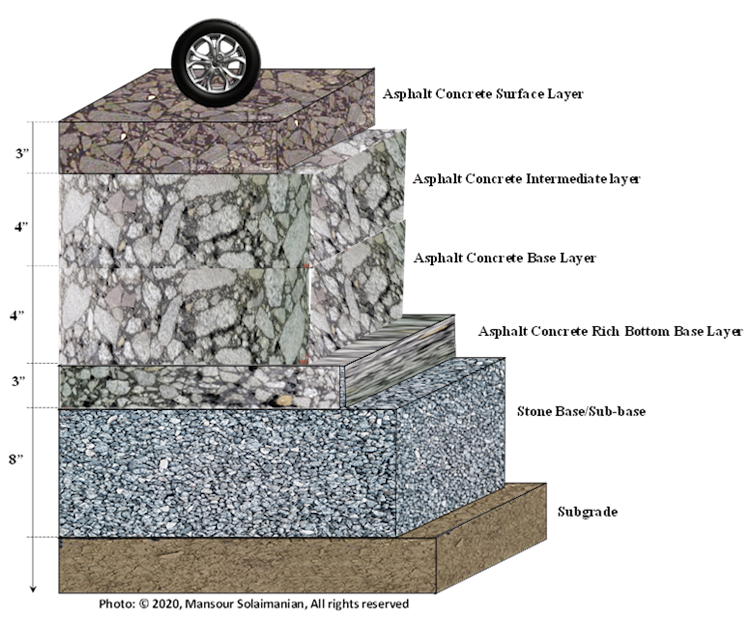
Engineers call the existing ground where the pavement goes the subgrade . On top of the subgrade goes a new layer of unbound soil and stone, where the aggregates aren’t glued together. This is called the subbase, or unbound aggregate base.
The base layer can be either stones packed together without any binding agent or a combination of stone and asphalt binder.
Once road builders make the base, it is time to build the asphalt concrete layers: the base layer, the intermediate layer and the surface layer. All these layers contain the aggregates – the pieces of rock and sand – glued together with the asphalt binder in some way.
Engineers determine how many layers to build and how thick to make each layer by figuring out how much traffic will drive over the road. The more traffic, the thicker the pavement needs to be. For example, on interstate highways, the depth of the layers combined could be 20 inches (51 centimeters) or more.
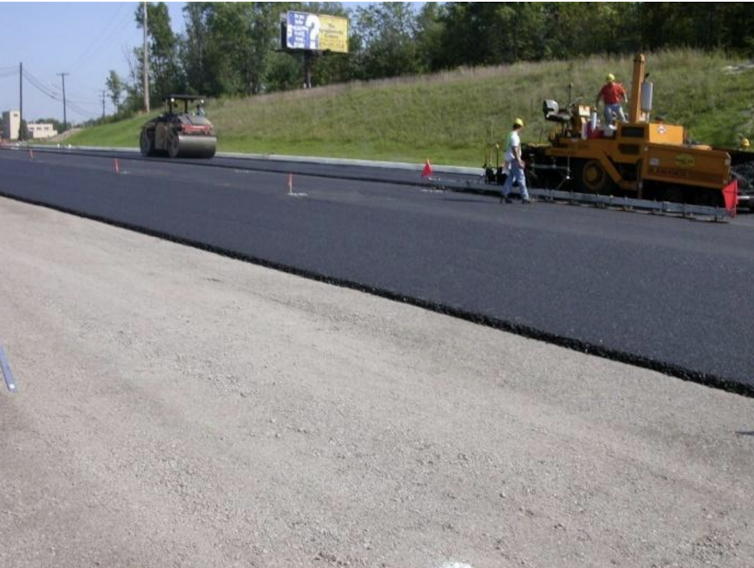
Building a strong road
The road builders place the material on the road with an asphalt paving machine called a paver. An operator runs the paver, which takes the materials from a truck and places them on the road. After that, heavy-duty rollers compact it down, make it strong and get it ready for vehicles.
For a strong and durable road, engineers first pick the best subgrade, or place on top of which to build pavement. If the subgrade is too weak, the road might crack and fail – even if the pavement uses the best materials.
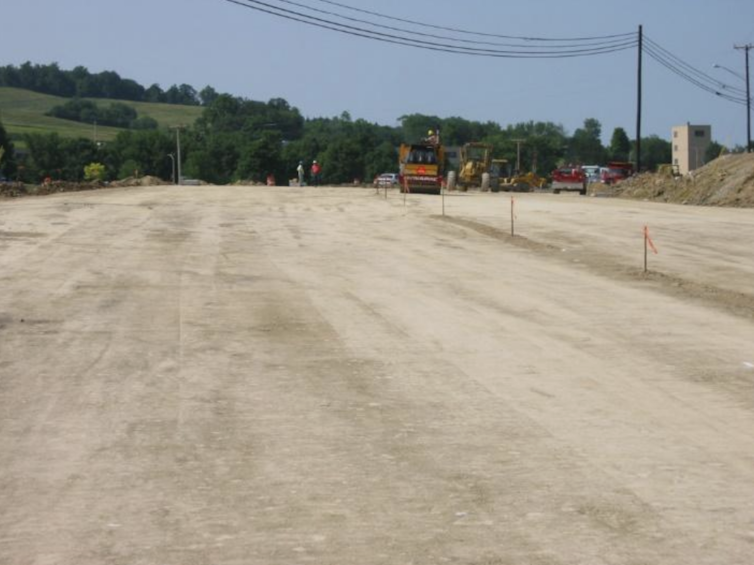
First, the road builders use rollers to pack the subgrade down. Once they’ve compacted the subgrade, they place the stone aggregates directly on top of the subgrade and compact them down. This aggregate base on the subgrade provides a sturdy foundation for the asphalt layers.
If the road builders do not use the right materials, or do not put them together correctly, or do not design the pavement structure for the expected traffic, then the road can crack, rut and fail .
Cracking occurs either at extremely low temperatures or from heavy trucks and buses repeatedly driving over the road. Rutting, which refers to noticeable impressions in the road’s surface, occurs mostly during summer heat under heavy trucks or at road intersections.
Potholes are a big road problem you’ve probably seen before. They often show up in the spring after water trapped in the pavement freezes over winter and then melts in spring. This melting process weakens the road, making it more breakable. Then, when vehicles drive over it, they can create potholes.
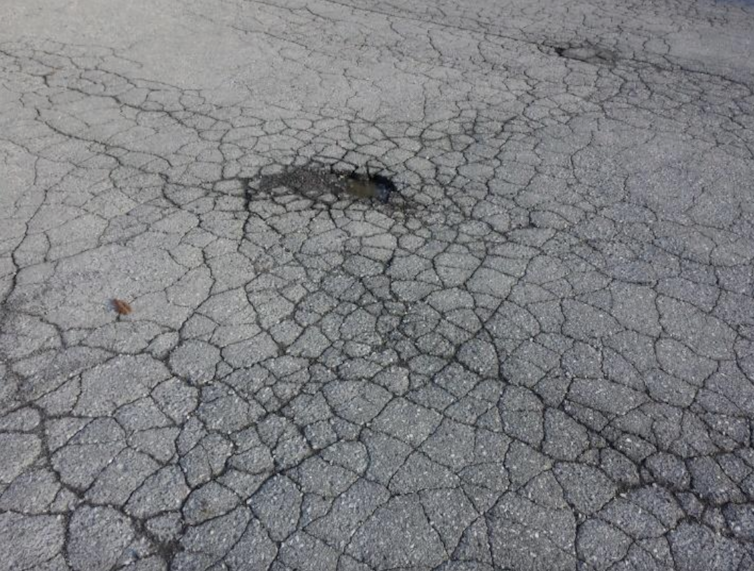
Before the road gets built, the materials undergo testing in a laboratory to make sure they can stand the loads from traffic and environment.
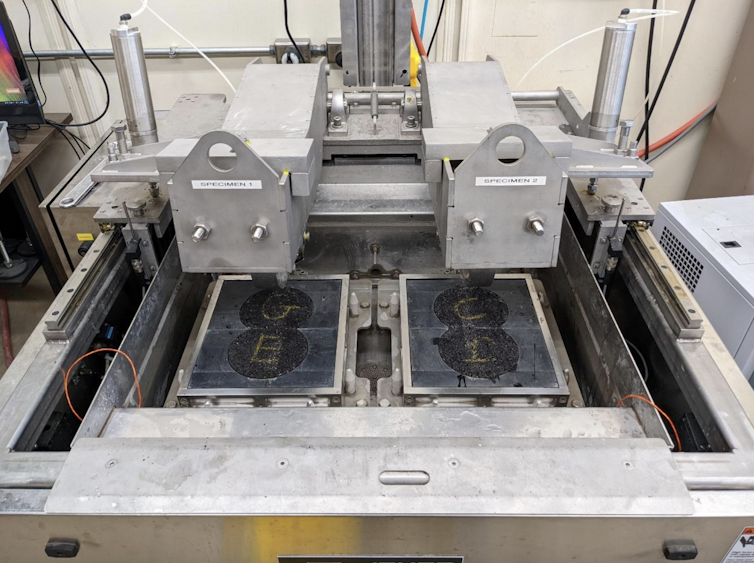
Engineers in the lab expose the pavement materials to both freezing and very hot temperatures to make sure they can withstand any weather. They also expose the pavement materials to water to make sure the materials will not fall apart if it rains or floods.
At the Penn State pavement laboratory , my team is testing asphalt mixtures to which we’ve added substances called modifiers. These include special polymers and fibers that could make the road stronger.
The next time you’re on the road, remember that it takes a good amount of engineering and tremendous teamwork to create that smooth pavement surface you drive on.
- Construction
- Transportation
- Materials science
- Road construction

Program Manager, Scholarly Development (Research)

Lecturer / Senior Lecturer - Marketing

Assistant Editor - 1 year cadetship

Executive Dean, Faculty of Health

Lecturer/Senior Lecturer, Earth System Science (School of Science)

COMMENTS
Resources from Heimler's History: To master all the WRITING SKILLS you need, get my ESSAY CRAM COURSE: +AP Essay CRAM Course (DBQ, LEQ, SAQ Help): https://bi...
If you're taking AP World History or AP United States History and feel unsure about how to approach the DBQ thesis, you've come to the right place! In this post, you'll learn about a DBQ thesis formula that you can use to: A) consistently earn the thesis point and
2. The AP Readers need to be able to see that your essay has one main point. 3. Your thesis statement should indicate exactly what your essay is about, and help keep you on track A thesis statement in APUSH is the position a student is going to take, the argument that is going to be made. It is therefore the answer to the question being asked.
Of the two free response questions, one is a long essay (worth 15%) and one is a DBQ. This means that the sole DBQ is, by itself, worth 25% of your total grade, making it the single most heavily-weighted question on the APUSH exam.. The APUSH DBQ will consist of a single open-ended prompt.To answer it, you'll have to create a persuasive argument that uses the documents you've been given on ...
a) Historical Reasoning. Responses earn one point by using historical reasoning to frame or structure an argument that addresses continuity and/or change over time in U.S. industry from 1865 to 1900. (1 point) The response might still earn the point if the reasoning used in the response is uneven or imbalanced.
The thesis statement of an AP History essay is the most critical element of the essay. It will be establishing the basis of the entire paper, and if done properly will outline a comprehensive well-thought out essay. For this reason, a lot of planning needs to be done for the thesis statement as your examples and phrasing could be the key to a ...
Don't be afraid to use multiple AP World DBQ prompts as part of your test prep strategy. The more DBQs you do, the better prepared you'll be on test day! Step 2: Practice Creating a Thesis. A thesis statement is a sentence or two, located in your essay's introduction, that explains what your essay will be about.
The thesis must consist of one or more sentences located in one place, either in the introduction or the conclusion. The thesis must make a historically defensible claim that establishes a line of reasoning about how debates over slavery in the period from 1830 to 1860 led the United States into the Civil War.
AP US History DBQ example 1. Google Classroom. About. Transcript. The document-based question (DBQ) is one of two main essays on the AP US History exam and usually requires analyzing changes or continuities over time in US history. In this video, learn about the structure of DBQs and tips and tricks to help you succeed on this challenging part ...
As I stated in a previous post on what the APUSH exam is all about, the goal of the exam is to test your historical thinking skills. Historians write arguments based on documents, and for this exam, you will, too. For a DBQ essay, you will receive several documents of varying length. You will be asked to respond to some historical prompt that ...
For the DBQ we're gonna do a standard five-paragraph essay, which means introduction. . . with a thesis statement, paragraph 1, paragraph 2, paragraph 3. These will all be the body paragraphs where we'll give our evidence in support of our thesis. And then a conclusion, which wraps up what we've said before, and really drives home our point.
Step 1: Start with a question. You should come up with an initial thesis, sometimes called a working thesis, early in the writing process. As soon as you've decided on your essay topic, you need to work out what you want to say about it—a clear thesis will give your essay direction and structure.
A. Thesis/Claim (0-1 points): 1. The response earned 1 point for thesis because it provides a historically defensible claim that establishes a line of reasoning in the first paragraph: "Commercial development has been historically one of the largest growth factors for the United States.
A: Thesis /Claim (0- 1) claim that responds to the prompt rather . Thesis/Claim: Responds to the prompt with a historically defensible thesis/claim that establishes a line of reasoning (1 point) To earn this point, the thesis must make a than restating or rephrasing the prompt. The thesis must consist of one or more
You could even try writing multiple thesis statements in response to the same prompt! It is a great exercise to see how you could approach the prompt from different angles. Time yourself for 5-10 minutes to mimic the time pressure of the AP exam. If possible, have a trusted advisor or friend look over your practice statements and give you feedback.
Let's take a look at a sample AP World History DBQ question and techniques to construct a solid thesis. Using the following documents, analyze how the Ottoman government viewed ethnic and religious groups within its empire for the period 1876-1908. Identify an additional document and explain how it would help you analyze the views of the ...
Types of Thesis Statements: 1. Direct: This a straightforward statement that clearly and directly answers the question. To a remarkable degree Jacksonian democrats succeeded in implementing their vision of American society. 2. Compound: Use this approach when trying to prove two main points. Use the word "and.".
1750-2001. 1890-2001. 1815-2001. Writing time on the AP Exam includes both the Document Based Question (DBQ) and the (LEQ), but it is suggested that you spend 40 minutes completing the LEQ. You will need to plan and write your essay in that time. A good breakdown would be 5 min. (planning) + 35 min. (writing) = 40 min.
You can earn up to one point for your thesis on both the document-based question (DBQ) and the long-essay question (LEQ) of the AP® U.S. History Exam. In order to earn this point, your thesis must do three things: 1. Respond to the prompt Your thesis must be a specific answer to the actual prompt, not a variation
APUSH essay structure. Flashcards. Learn. Test. Match. Flashcards. Learn. Test. Match. Created by. ... Basis for Analysis. 3. Roadmap sentence (3 subtopics) 4. Clear thesis statement. Body Paragraph 1. 1. Topic Sentence (subtopic 1 from Intro) 2. Evidence 1 with significance 3. Expand (relate to thesis) ... AP US History Period 7 (1890-1945) 77 ...
All documents are used as evidence to support a claim. The essay makes a complex and nuanced argument supported by strong evidence and analysis that goes beneath the surface. This sample essay was written in order to provide teachers and students with possible approaches to completing the AP US History DBQ.
The College Board requires your AP teacher to cover certain topics in the AP U.S. History course. As you complete your APUSH review, make sure you are familiar with the following topics: Period 1 (1491-1607) : Native American Societies Before European Contact; European Exploration in the Americas; Columbian Exchange, Spanish Exploration, and ...
Mission. The Purdue On-Campus Writing Lab and Purdue Online Writing Lab assist clients in their development as writers—no matter what their skill level—with on-campus consultations, online participation, and community engagement. The Purdue Writing Lab serves the Purdue, West Lafayette, campus and coordinates with local literacy initiatives.
Recommended time: 40 Minutes | 15% of Exam Score. Students explain and analyze significant issues in U.S. history. Students develop an argument supported by an analysis of historical evidence. The question choices focus on the same skills and the same reasoning process (e.g., comparison, causation, or continuity and change), but students choose ...
Pavement structure Asphalt concrete's pavement structure typically has three main layers: the base layer, the intermediate layer and the surface layer. The layers that make up pavement.